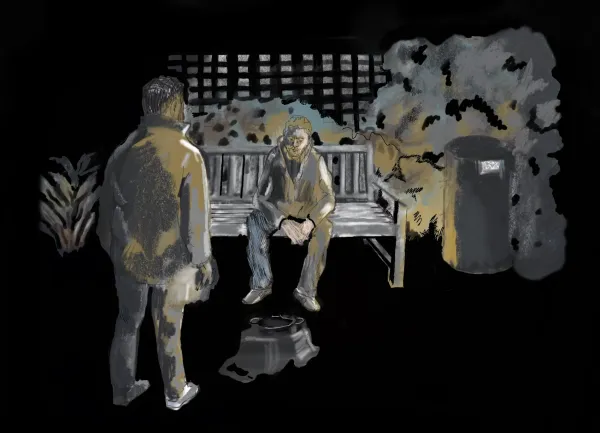Are there mammoth tusks in Manhattan's East River?

In a recent interview on “The Joe Rogan Experience,” which has an estimated audience of 11 million listeners per episode on Spotify, a guest from Alaska presented an explosive discovery: There are tens of thousands of priceless woolly mammoth tusks lying on the river floor. “I’m going to start a bone rush,” the guest, John Reeves, a fossil collector and gold miner, announced. The podcast episode, which aired Dec. 30, was an instant sensation. Without hesitation, teams of men and women from around the country drove, flew and floated to New York City for a chance at finding a many-thousands-year-old artifact that could be worth at least six figures. “You can’t win the lottery if you don’t play,” said one.
Scientists are training ants to sniff out cancer
Ants live in a world of odor. Some species are completely blind. Others rely so heavily on scent that ones that lose track of a pheromone trail march in a circle, until dying of exhaustion. Ants have such a refined sense of smell, in fact, that researchers are now training them to detect the scent of human cancer cells. A study published this week highlights a keen ant sense and underscores how someday we may use sharp-nosed animals — or, in the case of ants, sharp-antennaed — to detect tumors quickly and cheaply. That’s important because the sooner that cancer is found, the better the chances of recovery. “The results are very promising,” said Baptiste Piqueret, a postdoctoral fellow at the Max Planck Institute for Chemical Ecology who co-wrote the paper.

We're still not much closer to understanding what causes depression
Depression is the most common mental illness in the United States, affecting 30 percent of Americans at some point in their lives. But despite half a century of research, ubiquitous advertising, and blockbuster sales, antidepressant drugs just don’t work very well. They treat depression as if it were caused by a chemical imbalance: Pump in more of one key ingredient, or sop up another, and you will have fixed the problem. But the correspondence between these chemicals (like serotonin) and depression is relatively weak. An emerging competitive theory, inspired in part by ketamine’s effectiveness, has it that psychiatric disease is less about chemical imbalance than structural changes in the brain—and that a main cause of these changes is psychological stress.

Requiem for a string: Charting the rise and fall of a theory of everything
String theory began over 50 years ago as a way to understand the strong nuclear force. Since then, it’s grown to become a theory of everything, capable of explaining the nature of every particle, every force, every fundamental constant, and the existence of the Universe itself. But despite decades of work, it has failed to deliver on its promise. Like most revolutions, string theory had humble origins. It started in the 1960s as an attempt to understand the workings of the strong nuclear force, which had only recently been discovered. Quantum field theory, which had been used successfully to explain electromagnetism and the weak nuclear force, wasn’t cutting it, so physicists were eager for something new.

Maybe we're getting Long COVID all wrong
Advocates of the so-called contested illnesses that number among the most controversial topics in medicine—including chronic fatigue syndrome, or ME/CFS; chronic Lyme disease; and, more recently, long Covid—fiercely reject a new theory that it's a "functional neurological disorder," or a brain-processing problem. Critics say this is tantamount to telling patients that their suffering is all in their heads. ME/CFS activist and documentary filmmaker Jennifer Brea insists that FND is “not a diagnosis that is ready for prime time.” Other advocates quip that it’s an acronym for “fictional non-diagnosis.” They say that their illnesses are strictly physical; the idea that their mental health could have anything to do with their symptoms is as offensive as dismissing HIV as anxiety.

The great European house cat migration
Domestic cat bones around 8,000 years old have recently been found in both Serbia and Poland. This pushes back the arrival in Europe of one of humanity’s earliest companion animals by several thousands of years. Until recently, the thinking was that cats arrived in Europe only in Late Antiquity (roughly the 3rd to 7th century AD). As the above map shows, that still holds true for many parts of the continent, but an earlier influx via Asia Minor into the Balkans, and further north, seems to have preceded it. Because the five known varieties of wildcat (Near Eastern, Chinese, Central Asian, Southern African, and European) are quite similar and can interbreed, scientists until recently had a hard time pinning down in which part of the world cat domestication first occurred. Some even suggested that it had happened at multiple times and places.

Snowboarding on a sand dune in Chile
Exoplanet. Dune.
— Black Hole (@konstructivizm) January 26, 2023
Riding on the dunes in Chile
source: https://t.co/Jj7BEbx5Pj pic.twitter.com/QINUHdv64X



